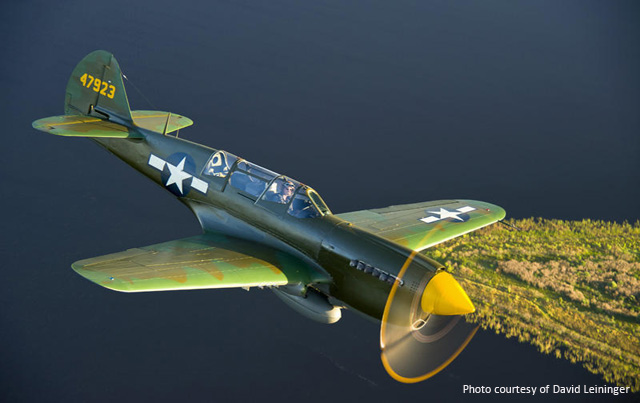
1944 Curtiss TP-40N
The Curtiss P-40 was originally designed and built in 1938. It achieved legendary status with the American Volunteer Group (AVG) who became famous as the “Flying Tigers” and painted shark teeth on their P-40’s large lower chin cowl. AVG leader Claire Chennault and his pilots flew as “volunteers” in China against the Japanese prior to the United States official entry into World War II.
The P-40 was the main fighter for the Army Air Corps at the beginning of the war and was flown by all the Allied countries. Its performance improved over time as its engine was developed to produce more power. Early versions were known as Tomahawks, while later versions were known as Kittyhawks and Warhawks.
Even with improvements, it was ultimately replaced by later designs with more advanced technology, such as the P-51 Mustang, P-47 Thunderbolt, and P-38 Lightning. P-40s were withdrawn from combat operations late in the war and delegated for training. However, the fierce legend and powerful styling of the P-40 will always inspire awe.
This aircraft was acquired when Kermit purchased the Tallmantz Collection in 1985 and is a movie veteran, having appeared in the films Death Chase and Tora! Tora! Tora!
Specifications
- Year Built — 1944
- Weight — 8,350 lbs
- Cruise Speed — 260 mph
- Top Speed — 378 mph
- Engine — Allison V-1710 (1500 hp)
- Armament — Six .50 caliber machine guns, 700 lbs bombs on wing racks
Kermit’s Comments
When I used to fly a P-40 alongside a sleeker P-51D Mustang, it was surprising how they would cruise at low altitudes at very similar power settings and fuel consumptions. This was because they had about the same engine horsepower at sea level. But when it came time to descend and buzz the airfield, the difference in the cleanliness of design soon became apparent. When the noses were dropped, with no change in power settings, the Mustang would run off and leave the P-40. I found myself pushing up the power to try to catch up.